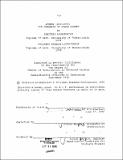Athens 1833-1979 : the dynamics of urban growth
Author(s)
Loukopoulos, Dimitris; Kosmaki-Loukopoulos, Polyxeni
DownloadFull printable version (29.20Mb)
Advisor
Julian Beinhart.
Terms of use
Metadata
Show full item recordAbstract
His thesis deals with the urban development of the city of Athens since its foundation as the capital of the newborn Greek State (1833) , until our days. The study focuses on two particular characteristics that dominate the form of the city: laissez-faire development and adhocist shaping, as they rise out of coinciding intentions and aspirations among the people involved in city making and individuals. Under the above assumption, we traced specific interactions or counteractions among social classes and groups, planning services, land speculation, building sector, and professionals--as they have affected the legislative framework , master plans' proposals or planning guidelines, and the specific physical structure of the city (main street layouts and lines, areas of the city, patterns of land subdivision, housing typologies), during the different historical stages of urban growth. We further try to analyze the present status of the above social and spatial relationships as a product of the historical process, and we use the outcome of this analysis to criticize the on going discussion "Athens 2000" , thereby connecting the thesis to the present- day problems of urban development . We approach the historical development of Athens by focussing on specific cases, that are characteristic of four major time spans, which marked t he course of city shaping. These four periods refer to: the foundation of Athens as capital of the new- born Greeks state and its first Master Plan, (1833); the prevalence of land speculation and unplanned growth (1880); the refugees' settlement and the resulting urban agglomeration (1920s); and the formation of the contemporary metropolitan area. In the light of the above historical examination we analyze the present situation, which, we believe , is representing a new potential threshold to the development of the city. After a long time of inaction, planning comes to challenge the laissez - faire status quo of city making. Our conclusions are concerned with the dynamics of the new developing trends, calling for a control over the city environment, versus the moment of resistance or inertias of the inherited practices.
Description
Thesis (M. Arch.)--Massachusetts Institute of Technology, Dept. of Architecture, 1980. MICROFICHE COPY AVAILABLE IN ARCHIVES AND ROTCH. Includes bibliographical references (p. 266-270).
Date issued
1980Department
Massachusetts Institute of Technology. Department of ArchitecturePublisher
Massachusetts Institute of Technology
Keywords
Architecture